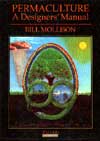Book Review
Permaculture: A Designer's Manual
by Bill Mollison
PERMACULTURE will become available again
in Febuary, 2003
Hardcover - 576 pages
Reprint edition (1997) Ten Speed Press; ISBN: 0908228015
Dimensions (in inches): 1.50 x 10.96 x 8.60
Books come and go. This year's must-read, best seller can be found on the remaindered table by next summer. While such "book books" often add value to our lives, opening our eyes to new horizons, making us laugh or cry, informing us about the important issues of the day or decade, perhaps even uplifting us spiritually, they don't fundamentally change the world. But while most books are, in their final disposition, just books, some are monuments which define those moments when history takes a turn.
Monuments, in my view, are not simply classics such as War and Peace that engage us by decrying the human condition. The litmus test for monuments is that they actually change the way we think, and live. How many people, after reading as great a tale as Dr. Zhivago, for example, or Gone With the Wind, actually struck out anew?
Monuments alter our perception of the possible, whether in the material realm, that of intellect or spirit, or all three. The Notebooks of Leonardo Da Vinci come to mind, as does the Origin of Species or Fuller's Synergetics. Ultimately, they influence the course of human history-and renew our hope.
Laid out and organized more like a textbook than a literary classic, bound not with cloth but unassuming cardboard, Bill Mollison's Permaculture, A Designer's Manual's appearance, though attractive, belies its monumental status. There is no hype on the cover of this hefty underground best seller, no raves from critics (at least on my 1988 version), no reference to the New York Times or any other legitimizing authority. The back cover has a picture of Mollison with his illustrator and photographer and the following definition:
Permaculture (Permanent Agriculture) is the conscious design and maintenance of agriculturally productive ecosystems which have the diversity, stability, and resilience of natural ecosystems. It is the harmonious integration of landscape and people providing their food, energy, shelter , and other material and non-material needs in a sustainable way. Without permanent agriculture, there is no possibility of a stable social order.
. . . . .
The philosophy behind permaculture is one of working with, rather than against nature; of protracted and thoughtful observation rather than protracted and thoughtless action; of looking at systems in all their functions rather than asking only one yield of them; and of allowing systems to demonstrate their own evolutions.
It is impossible to separate the life of an original thinker like Mollison from the product of his or her thoughts. Leonardo's attempts to translate his direct observations of nature into the design of mechanisms for human use, Darwin's extensive voyage on the Beagle, Fuller's half-blind explorations of his childhood environment that ultimately led to his understanding of natural geometry all demonstrate the essential connection between the self and the planet that thrives in the creators of monuments. Because of the depth and intensity of their connection, such creators seldom view themselves as geniuses, or especially deserving of praise, as much as simple instruments of conveyance, messengers of the gods that be. They know that without the wellspring of nature they are nothing. Ultimately they are humbled by a presence larger than themselves, and partaking of their humility can reconnect the rest of us to our roots.
Like the great creators of intellectual monuments before him, from Thoreau to Einstein, Mollison led an original life. Ever searching, changing careers, driven by an unbounded curiosity and the need, and will, to survive, he worked as a "forester, mill worker, trapper, snarer, tractor driver, and naturalist"* as well as a wildlife biologist, museum curator, bouncer at dances, professor of biogeography specializing in Tasmanian aborigines, and, for the past thirty plus years, the "father" of Permaculture. He also spent a certain amount of his life on "walkabouts"—lengthy, one man treks in nature living off the land, observing, thinking. It was from these solitary adventures, more than anything else, that he came to understand nature's secrets.
What his vast experience gave him, and he as been generous enough to give us, is not only an in-depth understanding of how natural systems sustain themselves, but, more importantly, the reduction of natures "operating principles" into a coherent, readily understandable "manual," for designing our own systems in accordance with those principles. Mollison gives us ecology, in the broadest meaning of the word, not as an abstract science burdened with baffling equations, but as a rich practicum, participatory and within the grasp of anyone who cares to make the effort of reading, then trying, then reading again. Permaculture is to ecology as medicine is to physiology, the good of it.
Beginning with a discussion of individual responsibility for stewardship and ethics toward the land, moving through fascinating chapters on patterns, climate, soil, and water and the specifics of designing for various climate types, and ending by offering environmentally and socially sound alternative to our current, crazy political and economic systems, this huge book is almost impossible to put down. Impossible, at least, for anyone who has a passion for saving the planet.
If we begin farming and managing the land as Mollison explains we should, there is still time to turn our global environment around. His monumental book does nothing less than show us how we can replenish the earth and make her healthy once again.
* from a biographical note on Mollison in the front pages of Permaculture.
